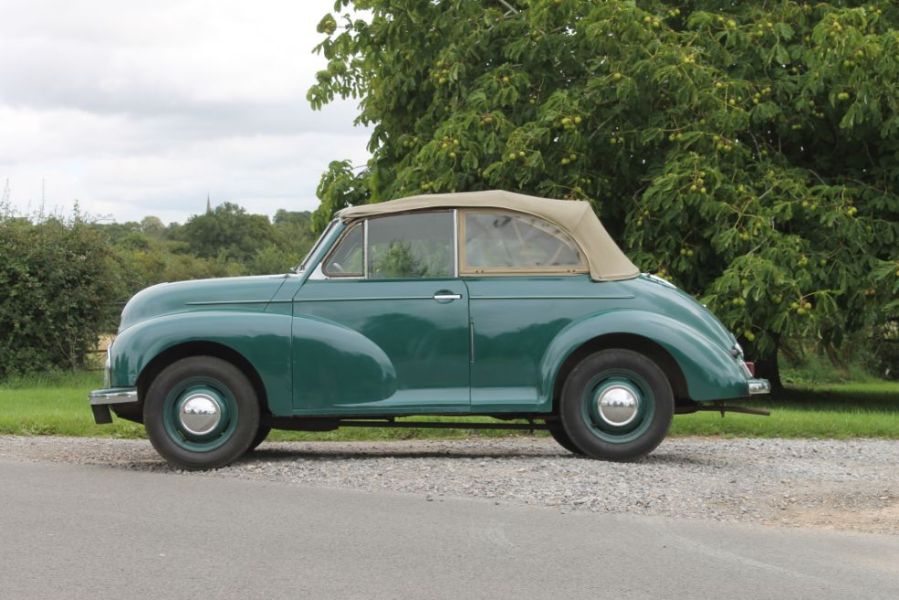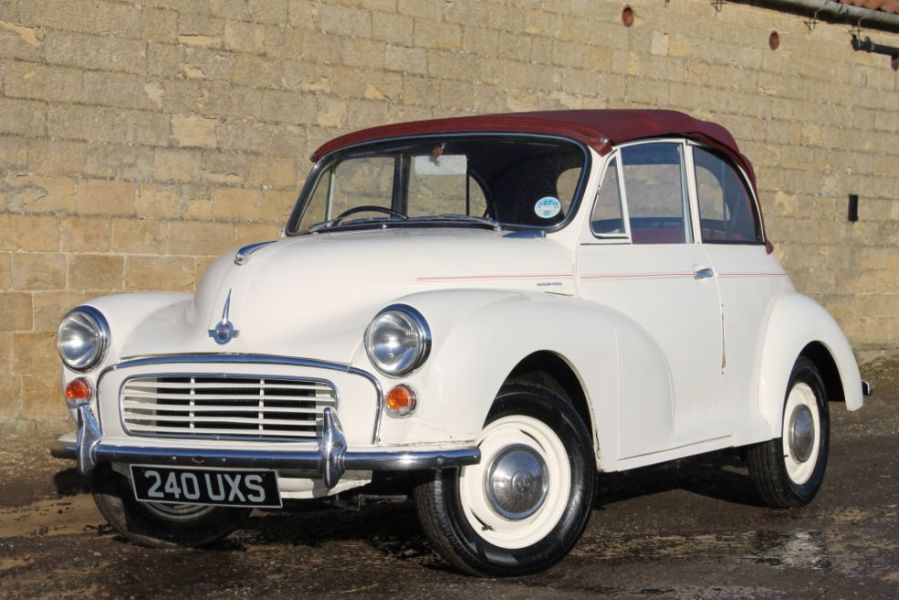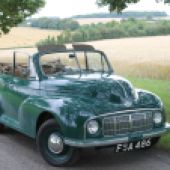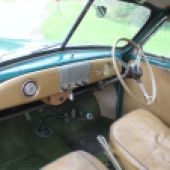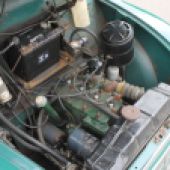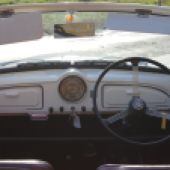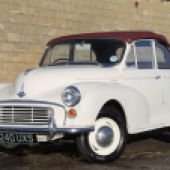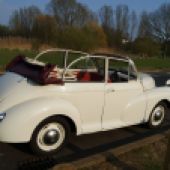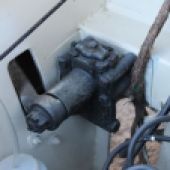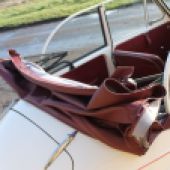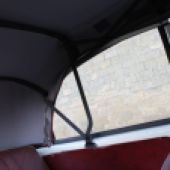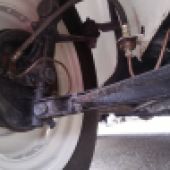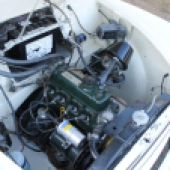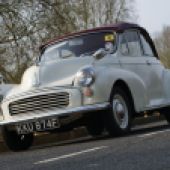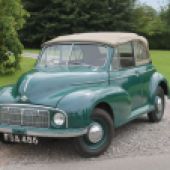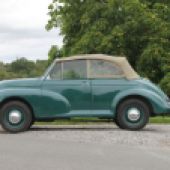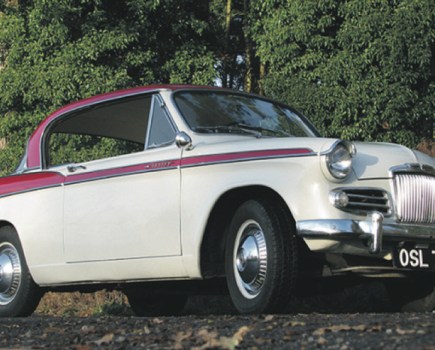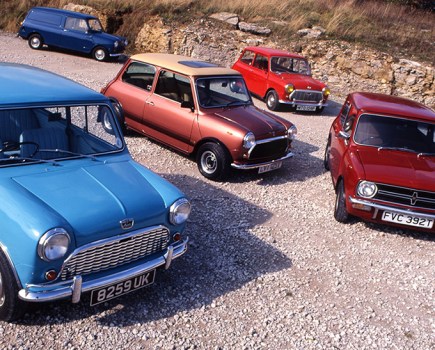Few cars have quite the same amount of charm as a Morris Minor Tourer. But letting that charm blind you can be an expensive mistake. Which is where this guide comes in
Words and images: Jack Grover
For a car that was so modern at its release in 1948, the fact that the Morris Minor was available as a soft top from the very start can seem unusual. But this was the tail end of an era when convertibles were, far from being glamorous and upmarket, were the budget option for bodywork – a holdover of the days of timber-framed, canvas-skinned bodies, cyclecars, Austin Sevens with ‘Chummy’ bodywork and – as far as Morris was concerned, the popular Morris Eight Tourer. The Morris ‘MM’ Minor’s contemporary, the Hillman Minx, was also available as a convertible. Notably its main rival, the Austin A30, was only offered as a saloon when it debuted a few years later. With a strong focus on exports, it made sense to offer a drop-top Morris Minor for warmer and sunnier climes. In fact, unlike its Morris Eight predecessor, the MM Minor was priced identically for saloon and tourer versions.
The original MM Minor was tourer in the true, traditional sense of the word, since it had removable sidescreens of perspex and vinyl that served as the rear windows and had to be stowed when the hood was down (the front windows always wound). In 1951, just before the launch of the Series II Minor, the bodywork was changed so the rear windows and frames were now fixed in place and made of glass and steel. This now technically made the Minor a ‘fixed profile convertible’, like the Citroën 2CV, although in the Minor’s case the rear window still folded away with the roof. Morris itself swung between calling these models Convertibles or Tourers, especially in the UK, although officially they retained the ‘T’ character in their chassis numbers (more of which below). In the years since there is a widespread (but not universal) habit of people in Morris Minor circles calling genuine factory-built soft tops Tourers and those converted from saloons Convertibles, but you can also find it used in the true sense to differentiate the pre- and post-1951 versions. For simplicity’s sake, we’ll call them all Tourers.
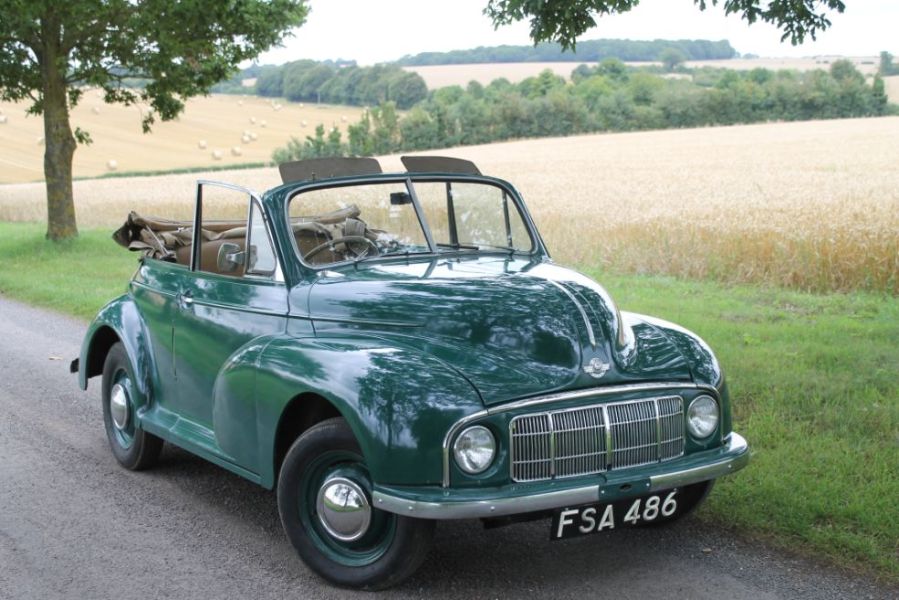
In the early 1950s Tourers had made up around a third of Minor production, but this dwindled during the production run of the Minor 1000 as more buyers preferred the quieter, less draughty, less damp and less fussy saloon – a trend that accelerated as motorways and other fast roads became more widespread. From the introduction of the 1098cc Series V Minor in 1962 Tourer sales took a steep dive – fewer than 3500 were built between that date and the end of 1967 (representing about a tenth of total production) – and when British Leyland took control only a few hundred were being built per year. And they were still being sold for the same price as the saloon and were certainly losing money. The Minor Tourer was the first casualty of British Leyland rationalisation and the first Morris Minor variant to end production.
But the Tourer has proved much more popular as a classic than as a new car, and they are much more commonly seen today than they were in the 1960s. This is because for the past 30 years or so there has been a thriving market in converting saloons into, well, convertibles. This is not a difficult or complex job and adds greatly to the appeal of a car that may well only ever be used in fine weather and on slow roads in any case. Kits to carry out the conversion are available from several sources and, when the work is done properly, are virtually indistinguishable from the genuine article.
Bodywork
But you do have to check that that work has been done properly. And that’s not just because there is a small price premium on genuine Tourers versus conversions, however good the conversion is. It’s because if the job hasn’t been done to the proper standards then the resulting car will not drive as well as it should, will be prone to distortions and damage of the body and could even be dangerous.
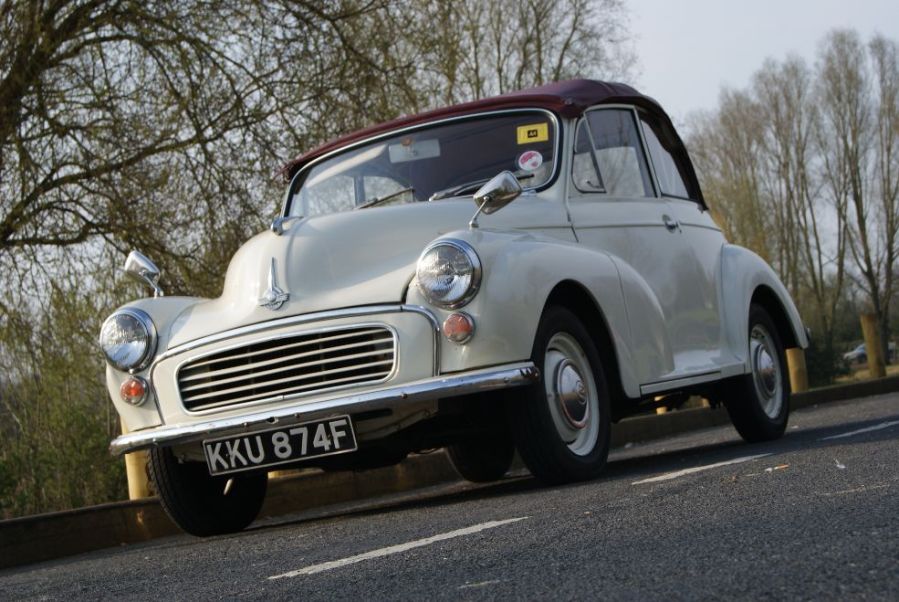
You need to be certain what you’re looking at and potentially buying. MM-type Minors had no indicators for bodystyle on their chassis plates (it only indicates that it is indeed a Morris Minor and what sort of paint it has). From 1952 to 1958 the second letter of the chassis code denotes the body – a ‘C’ indicates a convertible while ‘B’ indicates that a car was originally a two-door saloon. From 1958 to the end of production you want to see the third letter being ‘T’ to indicate a genuine Tourer. The first three letters will be ‘MAT’, while a two-door saloon will show ‘MA2S’ (‘MAS’ would be a four-door saloon, but for obvious reasons they are not readily converted).
To make up for the loss of rigidity from removing the roof Morris added an extra strengthener to the inside of the box section formed by the inner and outer sills, wedge-shaped gusset plates bracing the B-posts on top of the sills and braces under the dashboard; instead of the footwells, fascia and door posts meeting at a plain right angle, there are curved ‘buttress’ pieces in the corners. Some older conversion kits used steel tubes along the sills or on the B-pillars. So long as extra strength had been put in the right places, this is a good sign. Also look at the edge above where the windscreen surround ends – this was finished with a pressed edge and a metal finisher on the genuine ones. It’s easy to reproduce during a conversion but if the welds, corners and general finish here looks a bit homespun that can point to some cut corners. A really thorough conversion will also fill the holes for the courtesy light above the rear view mirror, which was present on the saloon but not on the convertible.
New hoods start from £400 or so for a good quality one in the original Everflex material, up to double that for a mohair one in a special colour. So a tatty hood is not a dealbreaker by any means – use it as a haggling point. But if you want a Minor to just drive away and enjoy, check for splits, cracks and tears in the hood, especially where it rubs or folds against the frame. Check that the rear window hasn’t gone opaque, isn’t cracked and that the stitching that holds it in place is still doing that. The same goes for the fasteners that hold the back edge of the hood down. Be sure to fold the hood up and down fully, checking that the frame folds and extends as it should and that it isn’t seized or bent. It can be a fiddly job single-handed but it should be straightforward and everything should slot and latch into place easily. The edges of roof material hanging down at the top of the doors (to cut down on draughts) can tear loose and flap about – easily stitched back together but another good haggling point. A Morris Minor Tourer should have a hood cover that protects the hood when its folded (and smartens up the appearance). It’s not crucial but, again, factor in the price of buying a new one if it’s not present or if it’s gone threadbare and mouldy from too many years sat in the boot.

Other than that, all the advice relating to the structure and body is the same as any other Morris Minor. Tourers are more prone to rotten floors and sills due to water getting into the inside from leaky (or left open) hoods, but both of those are key points to check on any Minor. And all Minors have a complex body structure with lots of box sections, overlapping panels and fillets so putting right any serious rot is very expensive – despite how strongly Minor values have picked up in the last decade, it’s still not financially worth it to patch up a rotten car. And that applies all the more so to one that’s a patchwork quilt of partial repairs and quick fixes by multiple well-meaning people in the past.
So really check those floors, the crossmember under the front seats, the inner sills (lift the carpets to check – and look for those extra reinforcement pieces) and the rear floor where the front hangers for the rear springs attach. Doors dragging on sill tops and wedge-shaped gaps between the doors and front wing are classic signs of a Minor that’s losing structural strength because of rusty innards. Without a roof, Tourers are more prone to suffering in this way and they will quickly start sagging in the middle if a soft-top conversion has been done without the required extra bracing. Check the door hinges by gently wobbling the doors when they’re open – no movement is ideal, but any movement should be in the hinges, not because the bulkhead they’re attached to is flexing.
Engine and transmission
Now we’re into very familiar and relatively safe territory, since a Morris Minor Tourer is no different in this department to any other Moggy, and any issues here can be put right at relatively low effort, time and cost.
The original MM Minor had a 918cc sidevalve engine. Parts for this are easier to find that you’d expect, but its rarity and its modest performance make it a somewhat specialist interest. The same goes for the Morris gearbox it is attached to. These and the Series II cars do at least have oil pressure gauges, so you can check that that rises quickly and stays at at least 40psi when driving. Listen for rattling pistons and clattery tappets and check for excessive crankcase pressure – if none of these are present then the engine is basically healthy. Check that the gearbox synchromesh (on fourth to third and third to second, like all subsequent Minors) works and that, while they often make a smooth whine in the lower gears, they’re not rumbling or screaming because of worn bearings.

Series II Minors had the 803cc version of the famous BMC A-Series. This is a rare size today and some 803-specific parts are hard to source. In the Minor it was also prone to bottom-end damage due to undersized crank journals and low overall gearing in the Morris. This isn’t really a problem in the gentle life of your average Minor today, but pay attention to the oil pressure gauge and listen for rumbling bearings under load.
By far the most practical powerplants are the 948cc and 1098cc A-Series found in the two generations of the Morris Minor 1000. Inherently sturdy, infinitely rebuildable and blessed with total parts support, there is little to worry about here. Check the overall health of the engine by seeing how much ‘chuff’ comes out the oil filler cap at idle with a hot engine (you want to see minimal amounts at most), and for any blue exhaust smoke showing burning oil. Oil leaks are almost a certainty but if it’s more than an ooze or a steady drip it requires at least a strip down and new seals or it may be excessive crankcase pressure from worn pistons pushing oil out of every orifice. A-Series engines tend to sludge up their waterways if not treated to at least occasional coolant changes and flushes, so see that the coolant in the radiator is clean and has a good mix of antifreeze and check for signs of mixing water and oil that could indicate a blown head gasket. Slapping timing chains and chattering valve followers are also common age-related problems, as is sagging oil pressure shown by a flickering warning light at a hot idle. A 948cc Minor in good condition should reach, and sit at, 60mph without feeling forced although it will still take a good while to get there. The torquier 1098cc should feel much more spry and should be able to cruise (albeit in a busy and blustery fashion in a Tourer) at 70mph.
Common engine upgrades include an unleaded cylinder head, electronic ignition, a solid state fuel pump (no mechanical points), an alternator and a high-speed starter motor. None of these are essential but they do all make the car more reliable and easier to keep running sweetly. Larger-capacity (1275cc) engines are also quite easy to find, but you really want to see brake upgrades to go with the extra power.
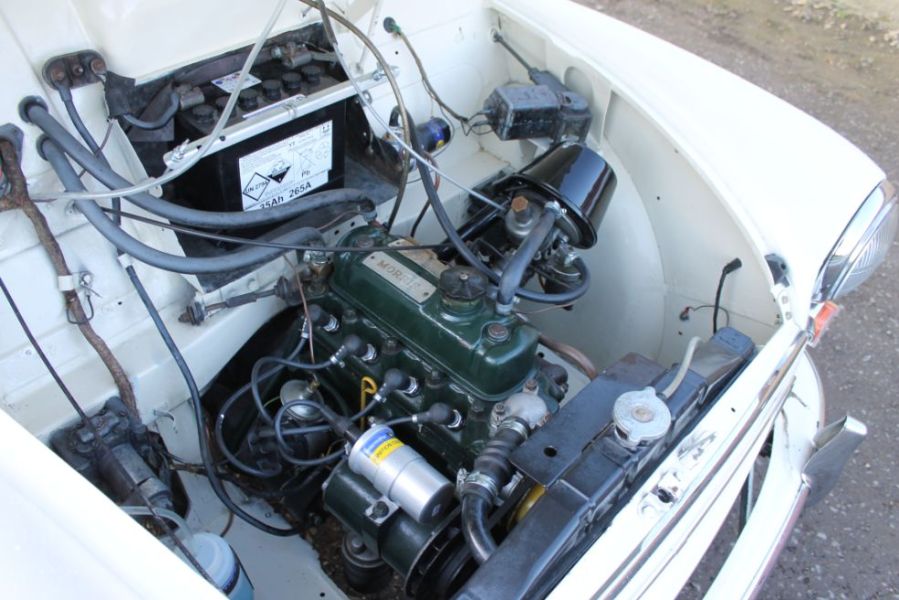
Make the same checks on the gearbox of the A-Series cars as mentioned for the MM, although these units are available rebuilt on exchange and are well-served for individual parts. The 1098cc cars have a stronger, quieter gearbox with much more effective and longer-lived synchromesh. Come on and off the throttle sharply a few times in second and third gear – if the ‘box pops out of engagement then it is generally worn and needs a rebuild.
The final drive is rugged but the bearings may be whining at higher speeds. They can go on like this for years so as long as it’s not too intrusive and it’s not the rough screech of bearings on their last legs, this is not an issue. More bursts of on/off power will show if there is wear in the axle half-shaft splines. Again, slight leaks from the pinion oil seal are common (but be sure the axle isn’t running dry) but if it’s more serious a rebuild is on the cards.
Suspension, steering & brakes
The most infamous fault on a Morris Minor is the lower trunnions on the front suspension – or, more accurately, where the lower part of the steering upright mounts to that trunnion. It’s a threaded fitting which if not properly lubricated seizes and wears. That wear then grinds away the threads until the upright pops out of the trunnion and the wheel flies up into the wheelarch. Look for signs that grease has been regularly applied – both that a grease gun has been on the grease nipple within the last decade and that the grease has actually been working its way through the trunnion. Get the front wheel off the ground and wobble it top and bottom to show up any wear in the trunnion or the top link. Seizing uprights will also make the steering go heavy and stiff (and it should be delightfully smooth on a Minor) so check this too. Worn trunnions will produce vague and wobbly steering on a test drive, and while a Morris Minor Tourer won’t drive as smartly as a saloon, the steering should always be sharp and accurate with very modern-feeling front end stability. Beyond the trunnion issue there is little that can or does go wrong with the Minor’s steering system so long as the bushes and ball joints are in good condition.
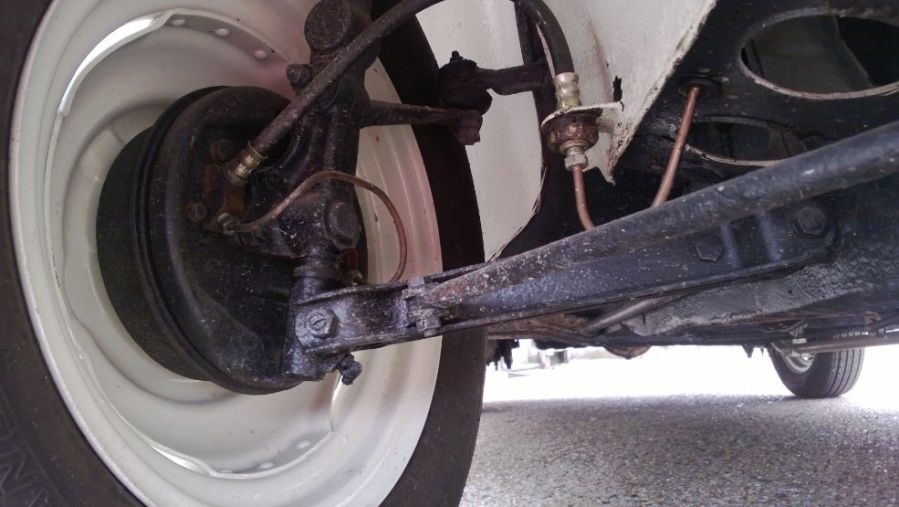
There are lever arm dampers on all four corners, so look to see if these are leaking from the valve spindles. They won’t have the same power as later telescopic dampers, but if they’re not keeping the body under decent control and risking causing sea sickness, then they either need replacing (£150 for brand new ones, less for reconditioned) or just need topping up with oil.
Check that the rear leaf springs aren’t either seized solid (which produces a stiff, hopping sort of ride quality) or sagged with age (which tends to make the car sit tail-down and bottom out over large bumps). Broken leaves can be heard by creaks or twangs from the underside.
Brakes most commonly suffer from lack of use, leading to seized wheel pistons, perished seals and rusty drums. The master cylinder is mounted under the floor in a metal body, so it’s hard to see the level and cleanliness of the fluid, but if the cylinder looks like a shipwreck artefact that isn’t a good sign. Check the brakes lines – solid and flexible – for corrosion and perishing, and the backplates of each drum for fluid leaks. The standard all-drum setup should be perfectly adequate for the performance of any Morris Minor Tourer so long as it’s in good shape. Aftermarket kits with front disc brakes and/or vacuum servos are common and worth having if you’re planning on using a car on any but the most bucolic roads today.
Interior, trim and electrics
Most Morris Minor Tourers will have rather basic and durable interiors consisting of painted metal and vinyl trim – earlier cars are more likely to have leather. Seat coverings, door trims and carpet sets are all available new in a multitude of colours and materials, although replacing it all at once will take a lot of time if you do it yourself and a lot of money to get someone else to do it. On Tourers, be aware that leaky hoods (and occasional dowsings in sudden rain showers) can cause more damage to the cabin materials than on a saloon, so look for water stains.

The electrics of a Minor are very simple and the Tourer doesn’t even have the interior light! Check that the dynamo puts out a charge (do the headlamps get brighter as the revs are raised above idle?), that the wiring is in good shape and there’s no interference between one circuit and another, pointing to bad earth connections. If halogen headlamps, a stronger heater fan, a radio, heated windscreen, 12-volt or phone charging socket and so on have been fitted (and they call can be to a Minor) then really you need an alternator to put out enough juice. And check that all additions are adequately fused and that more powerful lamps are safely run through relays rather than the original switches.
Morris Minor Tourer: our verdict
The appeal of the Morris Minor Tourer is obvious, as are the reasons why their numbers are, if anything, increasing as the years go by and more conversions are carried out. The Morris Minor is a likeable and easy car to live with, has better parts and specialist support than some cars a fifth of its age and prices are still perfectly reasonable. And the Tourer adds the ability to get the wind in your hair and the sun on your face to those fine qualities.
As to what those reasonable prices are: The very best with restored bodies, retrimmed interiors and overhauled engines being supplied from well-known dealers or Moggy specialists with a warranty go for £12,000-15,000 – that being for a Minor 1000. £10,000-12,000 will get you the best of the crop from private sales, and £8000-10,000 is the amount a very good but typical example – an older restoration that has been lightly used and properly maintained since. Less pristine but still solid and perfectly useable cars will be £5000-8000. Below that is where cars with problems will start to appear – £3000-5000 will get you a fundamentally fine car with a tatty interior and a whiny gearbox, say, or one that’s mechanically solid and with a lovely interior but in need of some new floors. Below that come the rolling restoration and project candidates, which are not as common as they once were since so many Morris Minor Tourers have now been restored.
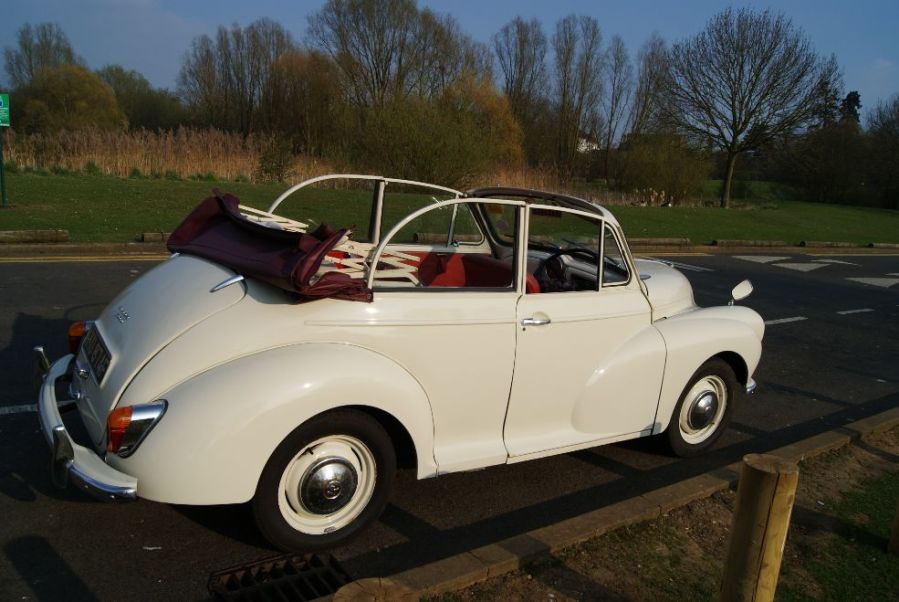
Morris Minor Tourer timeline
1948
Morris ‘MM’ Minor is launched with ‘low light’ front end and 918cc sidevalve engine. Two-door tourer with flexible removable side screens and duck canvas hood offered from the start.
1951
Headlamps moved from alongside the grille to above the front wings. True tourer body replaced by convertible with fixed rear windows. Hood frame changes from using three hoops to four.
1952
Series II Morris Minor introduced with 803cc A-Series engine and Austin-sourced gearbox, driveshaft, final drive and rear axle.
1954
Front styling revised with wider, horizontal-slatted grille. New interior look with large central-mounted speedometer. Larger tail lamps also fitted.
1956
Morris Minor III launched with 948cc A-Series engine. Windscreen changes to one-piece wraparound style, with hood frame and top rail of Tourers altered to suit.
1961
Flashing indicators replace original semaphore type. Tourers no longer available with leather seats.
1962
Morris Minor Series V launched with 1098cc engine, improved gearbox and larger front brakes.
1963
Combined side/indicator lamp units fitted at front, with orange rather than white indicators. Larger multi-function tail lamps fitted.
1964
Fresh-air heater unit with two-speed fan installed, plus revised fascia with white-on-black speedometer, toggle rather than push/pull ancillary switches and two-spoke plastic steering wheel.
1969
Last Morris Minor Tourer made in June. 45,842 were built in total.
